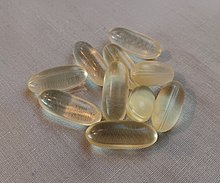
Seaweed oil, also called algae oil or algal oil, is used for making food, with the purified product almost colorless and odorless.[1] It is also under development as a possible alternative fuel and manufacturing agent.[2]
Seaweed oil is also used as a source of fatty acid dietary supplement, as it contains mono- and polyunsaturated fats, in particular EPA and DHA, both of them omega-3 fatty acids.[3] The supplement's DHA content is roughly equivalent to that of salmon-based fish oil supplement.[4][5]
Seaweed oil is also used for biofuel, pharmaceutical manufacturing, massage oil, soaps, and lotions.[2]
See also
[edit]References
[edit]- ^ "Seaweed". Harvard University T.H. Chan School of Public Health. 1 August 2023. Retrieved 29 September 2023.
- ^ a b Farghali M, Mohamed MA, Osman AI, Rooney DW (2023). "Seaweed for climate mitigation, wastewater treatment, bioenergy, bioplastic, biochar, food, pharmaceuticals, and cosmetics: a review". Environmental Chemistry Letters. 21 (1): 97–152. Bibcode:2023EnvCL..21...97F. doi:10.1007/s10311-022-01520-y. PMC 9547092. PMID 36245550.
- ^ Scott D. Doughman; Srirama Krupanidhi; Carani B. Sanjeevi (2007). "Omega-3 Fatty Acids for Nutrition and Medicine: Considering Microalgae Oil as a Vegetarian Source of EPA and DHA". Current Diabetes Reviews. 3 (3): 198–203. doi:10.2174/157339907781368968. PMID 18220672.
- ^ Arterburn, LM (July 2008). "Algal-Oil Capsules and Cooked Salmon: Nutritionally Equivalent Sources of Docosahexaenoic Acid". Journal of the American Dietetic Association. 108 (7): 1204–1209. doi:10.1016/j.jada.2008.04.020. PMID 18589030. Retrieved 20 January 2017.
- ^ Lenihan-Geels, G; Bishop, K. S.; Ferguson, L. R. (2013). "Alternative Sources of Omega-3 Fats: Can We Find a Sustainable Substitute for Fish?". Nutrients. 5 (4): 1301–1315. doi:10.3390/nu5041301. PMC 3705349. PMID 23598439.
Well, that’s interesting to know that Psilotum nudum are known as whisk ferns. Psilotum nudum is the commoner species of the two. While the P. flaccidum is a rare species and is found in the tropical islands. Both the species are usually epiphytic in habit and grow upon tree ferns. These species may also be terrestrial and grow in humus or in the crevices of the rocks.
View the detailed Guide of Psilotum nudum: Detailed Study Of Psilotum Nudum (Whisk Fern), Classification, Anatomy, Reproduction